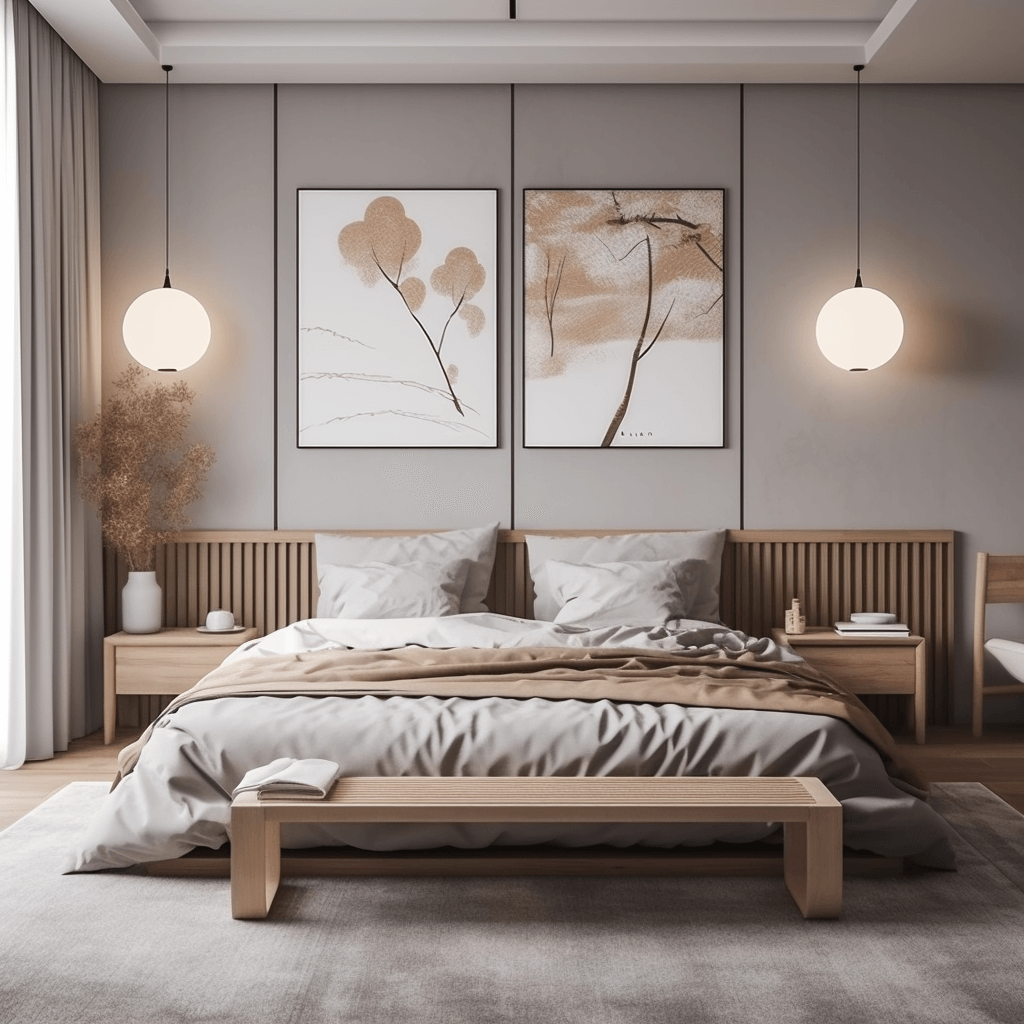TABLE OF CONTENTS:
Introduction
Japandi style, a fusion of Japanese and Scandinavian design principles, has become increasingly popular in recent years. This unique blend combines the simplicity and minimalism of Scandinavian design with the warmth, elegance, and natural materials of Japanese aesthetics. In this article, we’ll delve into the appeal of Japandi design for bedrooms, focusing on color palettes, furniture ideas, and ways to create a soothing and cohesive environment.
Japandi Color Palettes for Bedrooms
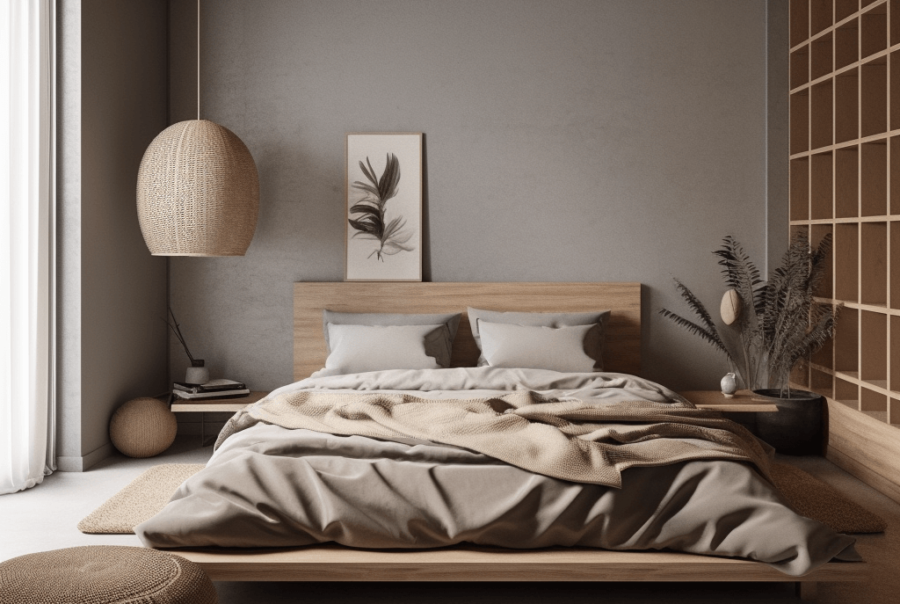
Neutral tones
The foundation of a Japandi color palette is built on neutral tones, such as whites, greys, and beiges. These subdued hues set the stage for a serene and uncluttered environment, providing a canvas for other colors to subtly complement and enhance the overall design.
Muted, earthy colors
Japandi design embraces the beauty of nature, and this is reflected in the color choices. Incorporate muted, earthy tones like soft greens, blues, and browns to bring a sense of tranquillity and balance to the space.
Color psychology and its influence on mood
Color can have a significant impact on our emotional state, making it essential to consider color psychology when designing a Japandi bedroom. Opt for colors that evoke calmness and relaxation, like soft blues, greens, and neutral tones.
Japandi Bedroom Furniture Ideas
Transform your bedroom into a serene and functional retreat with the right Japandi-inspired furniture pieces. In this section, we’ll delve deeper into the essential elements of Japandi bedroom furniture, including choosing the perfect bed and headboard, incorporating stylish bedside tables and nightstands, functional storage solutions, creating seating and relaxation spaces, and selecting versatile multi-functional pieces.
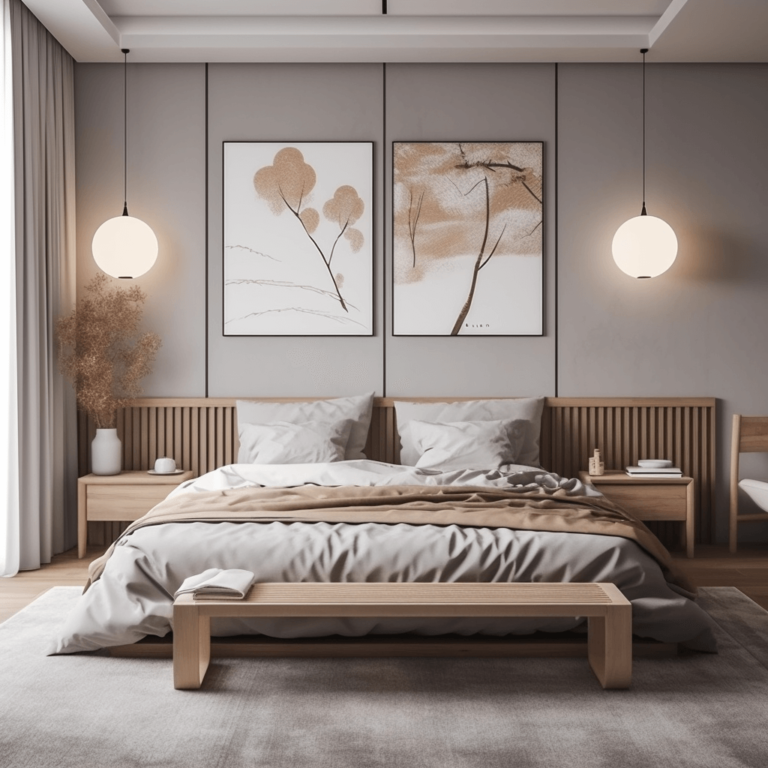
Choosing the perfect bed and headboard
A restful night’s sleep is crucial, and in a Japandi-style bedroom, the bed should prioritize comfort while reflecting the design’s simplicity.
Low-profile bedframes: Opt for bedframes with a close-to-the-ground design, clean lines, and minimal ornamentation. Low-profile frames emphasize the Zen-like calmness of Japandi design while making the space appear larger and more open. Consider materials like solid wood or metal with a matte finish to maintain the understated aesthetic.
Tatami-style beds: For an authentic touch, consider a tatami-style bed. These traditional Japanese sleeping surfaces consist of a firm, woven straw mat on which a futon mattress is placed. The simplicity and natural materials of tatami beds align perfectly with Japandi aesthetics, and their minimal design frees up floor space, making them ideal for smaller bedrooms.
Platform beds: Platform beds are another excellent option for Japandi-style bedrooms. With their low profile and simple design, they blend seamlessly with the minimalist aesthetic. Choose a platform bed made of natural materials, such as solid wood, and opt for a neutral finish to complement the overall design.
Japandi-style headboards: Choose a headboard that complements the bedframe and embodies the Japandi aesthetic. Look for designs with clean lines, natural materials, and subtle textures. Consider a wooden headboard with a minimalist pattern, a woven rattan headboard, or an upholstered headboard with a simple, neutral fabric.
Storage bedside tables, nightstands and wardrobes
In a Japandi bedroom, bedside tables and nightstands should be both functional and visually appealing.
Japandi nightstands: Opt for designs with clean lines and a mix of open and closed storage. Choose natural materials like wood, bamboo, or rattan, and stick to neutral colors that complement the rest of the room. A single drawer or shelf can provide just enough storage for essentials without overcrowding the space.
Floating Japandi bedside tables: For a more streamlined look, consider floating bedside tables that attach to the wall, creating a sense of openness and visual lightness. These tables can offer a sleek surface for a lamp, book, or glass of water without taking up valuable floor space.
Built-in wardrobes: A built-in wardrobe provides ample storage and creates a seamless, uncluttered look. Choose minimalist door designs, such as flush or sliding doors, and subtle hardware in finishes like matte black, brushed nickel, or stainless steel to maintain the Japandi aesthetic. Consider incorporating adjustable shelves and compartments for a tailored storage solution.

Japandi seating and relaxation spaces
A Japandi bedroom should be a calming retreat where you can unwind after a long day, and thoughtful seating options help create this atmosphere.
Minimalist seating options: Incorporate chairs, benches, or stools with clean lines, simple designs, and neutral upholstery. Stick to natural materials, such as wood or metal, and avoid overly ornate or bulky pieces. A single, well-designed chair or bench near a window can create a peaceful spot for reading or contemplation.
Reading nooks: Create a cozy corner for reading or meditation by adding a comfortable chair, floor cushions, or a plush bean bag, paired with a low table or a stack of books. Add a soft throw or blanket and a small side table for a cup of tea, ensuring that your relaxation space is both functional and inviting.
Multi-functional and modular pieces
Maximize space and maintain a clutter-free environment with versatile furniture pieces that adapt to your needs.
Storage benches and ottomans: These dual-purpose pieces provide seating and storage, making them perfect for Japandi bedrooms. Place a storage bench at the foot of the bed or along a wall to store extra linens, blankets, or pillows, while offering a place to sit when dressing or relaxing.
Foldable or stackable furniture: Look for items that can be easily stored or reconfigured, such as foldable chairs or stackable shelves. These pieces allow you to adapt your space to suit different activities or accommodate guests while keeping the room clutter-free.
Transformative furniture for small spaces: Consider pieces like wall-mounted desks or beds that can be converted into seating during the day to maximize space in compact bedrooms. These transformative furniture options allow you to create a multi-functional room without compromising on style or comfort. For example, a Murphy bed can fold up into a stylish cabinet when not in use, freeing up valuable floor space for other activities.
Other Japandi furniture items
Incorporate additional furniture pieces that follow the Japandi aesthetic, such as study tables and TV units, to complete your bedroom design.
Japandi study table: Choose a study table with clean lines, a simple design, and a focus on functionality. Look for materials like solid wood or metal in matte finishes that match the rest of your bedroom furniture. Incorporate storage solutions like drawers or shelves to keep your workspace clutter-free and organized.
Japandi TV unit: Opt for a TV unit with a minimalist design, natural materials, and a mix of open and closed storage. Stick to neutral colors and subtle textures, such

Japandi Bedroom Textile Ideas
This section will guide you through layering bedding, incorporating window treatments, and adding warmth with rugs and floor cushions.
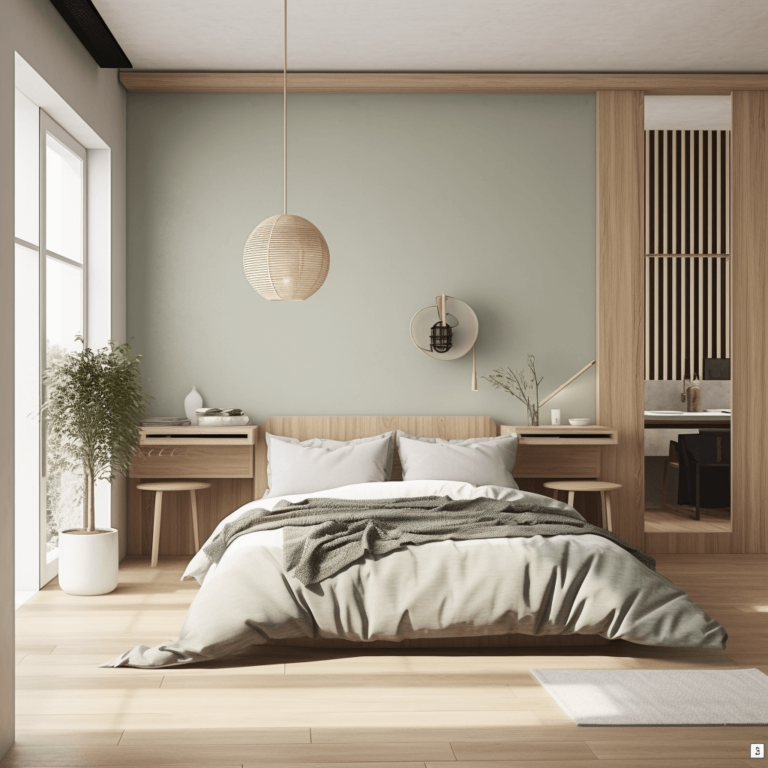
Layering bedding for comfort and style
The perfect balance between comfort and style can be achieved through thoughtful layering of bedding.
Selecting the right materials: Opt for natural, breathable materials like linen, cotton, or bamboo. These fabrics evoke the organic, earthy feel of Japandi design.
Coordinating colors and patterns: Stick to a muted color palette and avoid overly bold patterns. Consider incorporating a mix of solid colors, subtle textures, and minimalist patterns to create visual interest.
Incorporating window treatments
Window treatments play a crucial role in controlling natural light and maintaining privacy in your Japandi bedroom.
Simple and natural curtains: Choose light, airy fabrics in neutral tones, such as linen or cotton. Avoid heavy, ornate drapery that might overpower the space.
Japanese-inspired shoji screens: Shoji screens are traditional Japanese sliding doors made of translucent paper and a wooden frame. Incorporate these screens as window treatments to diffuse natural light and add an authentic touch to your Japandi bedroom.
Adding warmth with rugs and floor cushions
Complete your Japandi bedroom with rugs and floor cushions that add warmth and texture to the space.
Area rugs: Choose rugs made from natural materials like jute, sisal, or wool in neutral colors or subtle patterns. Place an area rug beneath the bed or seating area to create a cozy, inviting atmosphere.
Floor cushions: Incorporate floor cushions in your bedroom for additional seating or lounging options. Opt for cushions made from natural materials, such as linen or cotton, in muted tones that complement the rest of your Japandi-inspired decor
Japandi Bedroom Decor Ideas
In this section, we will explore Japandi bedroom decor ideas that blend the best of Japanese and Scandinavian aesthetics. Discover the perfect balance between minimalism, nature-inspired elements, and cultural motifs to create a serene and stylish bedroom space.
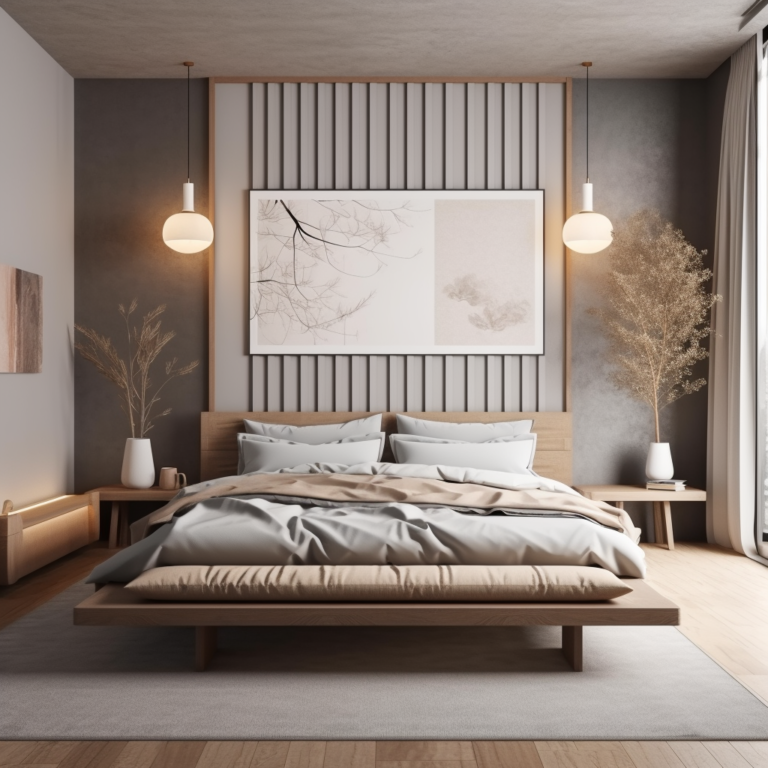
Wall decor and artwork
Japandi style emphasizes the importance of minimalist prints and paintings that reflect the essence of both Japanese and Scandinavian design. Incorporate nature-inspired elements, such as plants, landscapes, and animals, to bring life to your walls without overwhelming the space.
Japanese-inspired prints and motifs
Introduce Japanese art to your Japandi bedroom by choosing traditional woodblock prints, which often depict nature scenes and landscapes. Calligraphy and sumi-e ink paintings add a touch of elegance and sophistication, while reinforcing the connection to nature and simplicity. Look for pieces that showcase nature and landscape themes to create harmony in your bedroom design.
Scandinavian abstract art and minimalist designs
Incorporate Scandinavian art by opting for geometric patterns, line art and illustrations, or Nordic folklore and cultural motifs. These minimalist designs add visual interest without detracting from the overall simplicity of the space. Experiment with different color palettes, but maintain a focus on soothing, muted tones that contribute to the serene atmosphere.
Decorative accessories
Decorative accessories can add personality to your Japandi bedroom without compromising the minimalist aesthetic. Consider incorporating ceramics and vases with clean lines and neutral colors. Use textile and wood accents to bring warmth and texture to your space, such as woven baskets, throws, and wooden trays.
Creating a serene atmosphere with greenery
Adding greenery to your Japandi bedroom is essential for creating a calming, nature-inspired environment. Opt for air-purifying plants like snake plants, pothos, or spider plants, which require minimal maintenance and thrive in various lighting conditions. Complement these plants with stylish planters and displays made from natural materials, such as ceramic, wood, or woven rattan, to enhance the Japandi aesthetic.
Japandi Bedroom Lighting Ideas
The right lighting is essential to creating a peaceful and soothing ambiance in your Japandi bedroom. In this section, we’ll explore ways to embrace natural light and make smart choices when selecting artificial lighting. We’ll cover window placement, room layout, and the types of artificial lighting that best complement the Japandi style.

Embracing natural light
To make the most of natural light, arrange your bedroom furniture in a way that allows sunlight to flow freely throughout the space. Position your bed and other key pieces away from windows and avoid blocking the light with heavy or bulky furniture. This will create a bright, welcoming atmosphere that is a hallmark of the Japandi style.
Choosing the right artificial lighting
Ambient and task lighting
In addition to natural light, it’s essential to incorporate ambient and task lighting in your Japandi bedroom. Ambient lighting provides overall illumination, while task lighting focuses on specific areas for reading or other activities. Choose fixtures with a minimalist design, such as wall sconces or pendant lights, and opt for warm, soft lighting to create a cozy atmosphere.
Statement lighting pieces
Although simplicity is key in Japandi design, a well-chosen statement lighting piece can add a touch of elegance and interest. Look for sculptural pieces made from natural materials, such as wood or bamboo, that blend seamlessly with the room’s overall aesthetic.
Japandi Bedroom Organization Ideas
A well-organized space is essential for maintaining the calm, serene atmosphere of a Japandi bedroom. In this section, we’ll delve into the art of decluttering and offer practical tips for keeping your space tidy and efficient. We’ll discuss hidden storage solutions, maintaining a minimalist aesthetic, and ways to utilize vertical space.

The art of decluttering
Hidden Japandi storage solutions
To achieve a clutter-free Japandi bedroom, consider incorporating hidden storage solutions. Built-in wardrobes, under-bed storage, and floating shelves can help keep your belongings organized while maintaining the clean lines and minimalist aesthetic of the design.
Maintaining a minimalist aesthetic
Decluttering is not just about creating more storage space, but also about maintaining a minimalist aesthetic. Be mindful of the items you keep on display and consider investing in multi-functional furniture that serves dual purposes, such as a bed with built-in storage or a bench that doubles as a side table.
Practical organization tips
Utilizing vertical space
In a Japandi bedroom, it’s essential to make the most of every inch of space. Utilize vertical space by installing floating shelves, wall-mounted hooks, or a tall, narrow bookcase. These solutions can help you store and display your belongings without compromising the minimalist aesthetic.
Streamlining daily routines
To keep your Japandi bedroom organized, it’s important to establish daily routines that help maintain a clutter-free environment. Set aside time each day to tidy up and put away items that may have accumulated. By developing these habits, you’ll create a peaceful sanctuary that is always ready for relaxation.
Conclusion
Creating a Japandi bedroom is all about embracing simplicity, serenity, and a connection to nature. By carefully considering your lighting choices, decluttering your space, and implementing smart organization solutions, you can transform your bedroom into a tranquil oasis that embodies the Japandi aesthetic. Remember to maximize natural light, choose minimalist artificial lighting, and incorporate hidden storage solutions to maintain a clutter-free environment. With these tips in mind, you’ll be well on your way to designing a harmonious and inviting bedroom that serves as the perfect retreat after a long day. So, embrace the fusion of Japanese and Scandinavian design principles and start your journey towards creating a calming, restorative Japandi bedroom.

